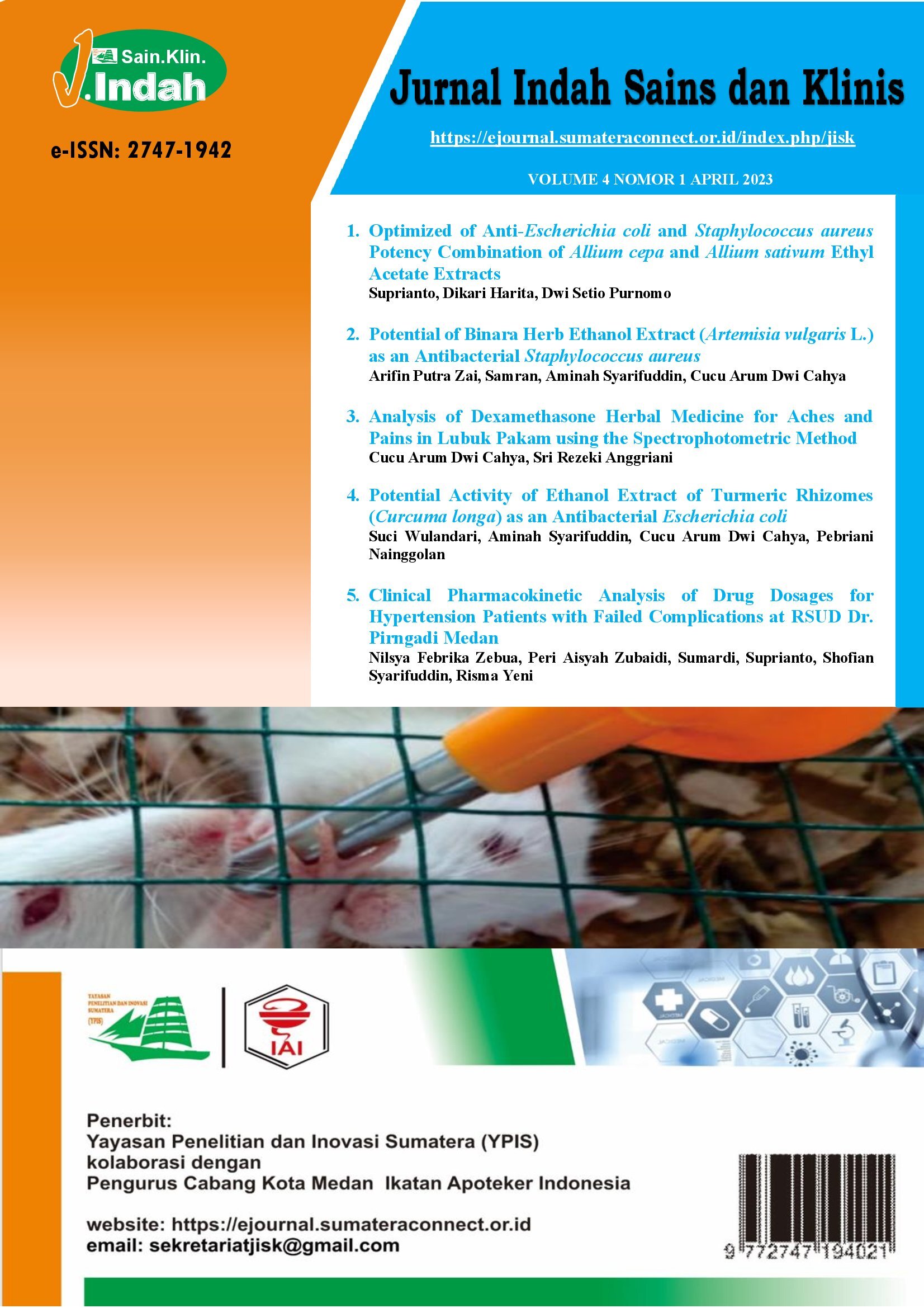Potential of Binara Herb Ethanol Extract (Artemisia vulgaris L.) as an Antibacterial Staphylococcus aureus
DOI:
https://doi.org/10.52622/jisk.v4i1.02Keywords:
Artemisia vulgaris L, diffusion, antibiotics, Staphylococcus aureusAbstract
Background: Herb Binara has potential as an antimicrobial against Staphylococcus aureus, because this plant has several compounds that have medicinal properties, including: alkaloids, saponins and flavonoids. This compound can act as a natural antibiotic. Objective: The study was aimed at finding out whether Binara extract has antibacterial potential. Methods: The study was carried out using a disc diffusion system to assess the antibacterial potential of Binara herbal extract. Antibacterial potency is based on the area of obstruction around the disc. The study used four extract concentrations (20, 40, 60, and 80%), clindamycin, and DMSO. Results: Test results for the antibacterial potential of the ethanol extract of Binara herb at a concentration of 80; 60; 40; and 20% each show the resistance area is 12.90; 10.50; 9.00; and 8.10 mm. Conclusion: Binara herb ethanol extract has potential as an antibacterial with moderate to strong potency criteria
Downloads
References
M. Radji, Buku Ajar Panduan Mikrobiologi Mahasiswa Farmasi dan Kedokteran. Jakarta: Penerbit Buku Kedokteran EGC, 2011.
E. Jawetz, J. L. Melnick, E. A. Adelberg, G. F. Brooks, J. S. Butel, and L. N. Ornston, Mikrobiologi Kedokteran. Jakarta: Penerbit Buku Kedokteran EGC, 2005.
K. H. Samadin and S. Aziz, “Pola Kepekaan Bakteri Staphylococcus aureus terhadap Antibiotik Vancomycin di RSUP Dr. Mohammad Hoesin Palembang,” Maj. Kedokt. Sriwij., vol. 46, no. 4, pp. 266–277, 2014.
H. A. Agoes, Tanaman Obat Indonesia. Jakarta: Salemba Medika, 2010.
E. Bangol, L. I. Momuat, and J. Abidjulu, “Aktivitas Antioksidan Ekstrak Etanol dan n-Heksana dari Daun Rumput Santa Maria (Artemisia vulgaris L.) pada Minyak Ikan,” J. Ilm. Sains, vol. 14, no. 2, pp. 129–135, 2014.
L. Febrina, I. D. Riris, S. Silaban, J. Kimia, U. N. Medan, and K. Karo, “Uji Aktivitas Antibakteri terhadap Escherichia coli dan Antioksidan dari Ekstrak Air Tumbuhan Binara (Artemisia vulgaris L.),” J. Pendidik. Kim., vol. 9, no. 2, pp. 311–317, 2017.
Departemen Kesehatan Republik Indonesia, Suplemen III Farmakope Herbal Indonesia: Edisi 1. Jakarta: Departemen Kesehatan Republik Indonesia, 2013.
J. B. Harbone, Metode Fitokimia. Bandung: Penerbit ITB, 1987.
N. Raihana, Profil Kultur dan Uji Sensitivitas Bakteri Aerob dari Infeksi Luka Operasi Laparatomi di Bangsal Bedah RSUP DR. Padang: Universitas Andalas, 2011.
S. Aziz, “Uji Efektivitas Antibakteri Ekstrak Etanol Daun dan Umbi Bakung Putih (crinum asiaticum L) terhadap Bekteri Penyebab Jerawat,” UIN Syarif Hidayatullah, 2010.
A. P. Ningsih and A. Agustien, “Uji Aktivitas Antibakteri Ekstrak Kental Tanaman Pisang Kepok Kuning (Musa paradisiaca Linn.) terhadap Staphylococcus aureus dan Escherichia coli,” J. Biol. UNAND, vol. 2, no. 3, 2013.
M. Ginting, S. Suprianto, S. F. Hanum, D. Meilani, and M. Sartika, “Uji Ekstrak Kulit Buah Mangga Arum Manis dalam Etanol pada Tumbuh Kembang Escherichia coli dan Salmonella typhi,” J. Indah Sains dan Klin., vol. 3, no. 2, pp. 1–5, 2022.
H. Widyaningrum, Kitab Tanaman Obat Nusantara. Yogyakarta: Media Pressindo, 2011.
I. R. S. Hidayat, R. M. Napitupulu, and M. M. Sp, Kitab Tumbuhan Obat. Jakarta: Agriflo, 2015.
S. T. Pratiwi, Mikrobiologi Farmasi. Jakarta: Erlangga, 2008.
R. M. Rumanti, S. Suprianto, J. Tarigan, and A. M. S. Ramadani, “Combinant Potential Antibacterial Zingiber Officinale Var. Rubrum with Cinnamomum Burmannii Against Staphylococcus Aureus,” J. Indah Sains dan Klin., vol. 2, no. 1, pp. 6–10, 2021.
S. R. Rahayuningsih, S. S. Patimah, T. Mayanti, and M. M. Rustama, “Aktivitas Antibakteri Ekstrak n-Heksana Daun Mangrove (Rhizospora stylosa Griff) Terhadap Bakteri Patogen Pada Ikan Nila (Oreochromis niloticus),” J. Mar. Res., vol. 12, no. 1, pp. 1–6, 2023.
T. P. T. Cushnie and A. J. Lamb, “Antimicrobial Activity of Flavonoids,” Int. J. Antimicrob. Agents, vol. 26, no. 5, pp. 343–356, 2005.
B. Kaczmarek, “Tannic Acid with Antiviral and Antibacterial Activity as a Promising Component of Biomaterials—A Minireview,” Materials (Basel)., vol. 13, no. 14, p. 3224, 2020.
Y. Yan, X. Li, C. Zhang, L. Lv, B. Gao, and M. Li, “Research Progress on Antibacterial Activities and Mechanisms of Natural Alkaloids: A Review,” Antibiotics, vol. 10, no. 3, p. 318, 2021.
Downloads
Published
Issue
Section
License
Copyright (c) 2024 Jurnal Indah Sains dan Klinis

This work is licensed under a Creative Commons Attribution-NonCommercial-ShareAlike 4.0 International License.









 This work is licensed under a
This work is licensed under a 
